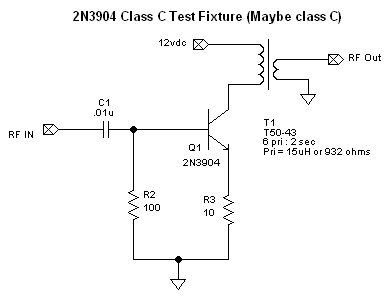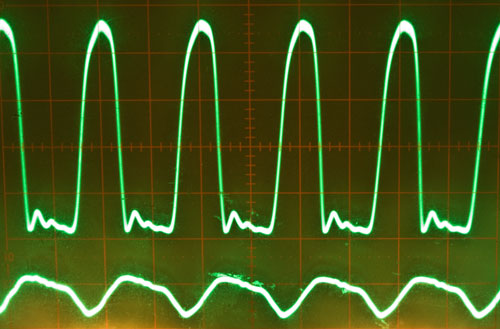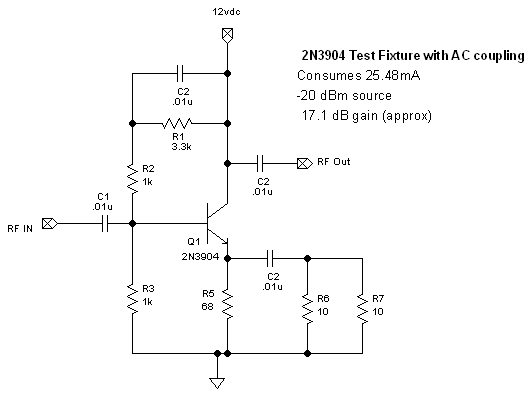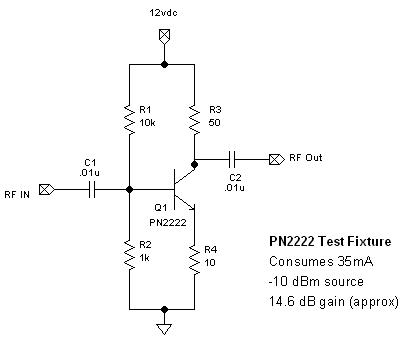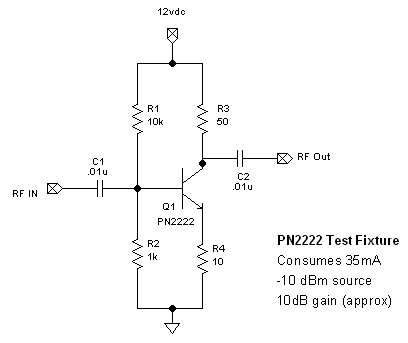Transistors: Classes A, AB, B, and C
I am still reading and trying to figure out the differences in how each class is biased.

Class A is the most common example and pretty well documented:
------------------------

Class AB or B is discussed in detail but very few math examples:
------------------------

Class C is discussed in detail but very few math examples:
------------------------
Open Questions:
I will try to come back and update this post with additional notes & corrections
as I learn more.



Class A is the most common example and pretty well documented:
R3 is controlling the majority of the current for the device
R1 & R2 are a DC voltage divider probably about ~1/2 the Voltage at the collector
T1 (which could also be a resistor) at the Q1 collector is ~ 1/2 Vcc
Tweak the R3 / T1 (or the resistor substitute or T1) ratio drive your power output.
Current hungry circuit.
Can easily get 10, 15, and approaching 20dB of gain
I am seeing 17dB of gain with 25mA with some additional AC feedback at the emitter,
and between the collector and base.
The amp is running 100% duty cycle.
------------------------

Class AB or B is discussed in detail but very few math examples:
Configure R1 & R2 for about 0.7v. This will largely determine what class you are
in. The higher the voltage the more likely you are to be in class AB or A. The lower
the voltage the closer to B or even C.
R3 is largely controlling the device current
T1 (which could also become a resistor) is being used to transform the output to match
the next stage.
The amp is running between around 50% duty cycle.
Normally this is used in a push-pull pair.
AB in a push-pull pair can have some cross-over distortion because there is a period
of time in the sine wave where there is no signal when both transistors are in the
off state.
Can be used for audio or SSB circuits as there is little distortion especially in
class B.
------------------------

Class C is discussed in detail but very few math examples:
Set R3 for current level of the device
R2 serves as a wideband load for the input driver. Decreasing
this resistance can improve stability at the price of gain.
The base only turns on when there is enough positive drive.
The duty cycle is less than 50%
Should only be used for CW or FM given the distortion in the sine wave.
Could be harmonic rich so output filter needs to be investigated.
T1 (which could also become a resistor) is being used to transform the output to match
the next stage.
I will design T1 for a 200 ohm to 50 ohm match. This is just
a shot in the dark initially but I need a starting point to test with. A T50-61 toroid
with 7 turns on the primary and 3 turns on the secondary will provide a transformation
of 220 ohms to 40 ohms. At 10MHz a T50-61 toriod with 7 turns is z=220, L=3.5uH,
C=72pF.
The input of this circuit is probably low impedance. For
my initial testing I will probably build a 50 ohm to 12 ohm transformer and see if
that helps. (I am using my signal generator for my initial testing which is 50 ohms.
I will probably use 8 turns to 4 turns on a T50-43 or T50-61 core.)
EMRFD suggests using a Zener diode at the collector that
is 3x the Vcc value but less than the transistor break down. The idea is to prevent
the transistor from self destructing at extreme voltage peaks while otherwise being
largely invisible to the circuit.
------------------------
Open Questions:
In class AB, B, and C how should we be be calculating the amount of current that we
designing for?
How should we be sizing T1?
T1 shown in the examples above is functioning as an RF choke, collector resistor,
and output transformer. (Lots of value from that one part.) The examples
that I have seen don't include much math or reasoning. It would seem like there is
some current limiting happening in T1 acting as a resistor that should be factored
in.
How does the R2 (base current) and T1 (collector current) ratio interact?
How do we model/suggest/approximate the power gain in these designs?
I will try to come back and update this post with additional notes & corrections
as I learn more.

